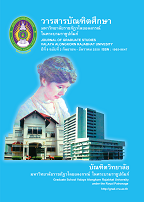การศึกษาศักยภาพการท่องเที่ยวเชิงวัฒนธรรมของวัดในจังหวัดปทุมธานี
Main Article Content
Abstract
การศึกษาศักยภาพการท่องเที่ยวเชิงวัฒนธรรมของวัดในจังหวัดปทุมธานี มีวัตถุประสงค์คือ 1. เพื่อศึกษาศักยภาพด้านการท่องเที่ยวของวัดในจังหวัดปทุมธานีที่สามารถพัฒนาให้เป็นแหล่งท่องเที่ยวเชิงวัฒนธรรม 2. เพื่อจัดทำเส้นทางท่องเที่ยวที่เชื่อมโยงระหว่างวัดที่มีศักยภาพในการพัฒนาให้เป็นแหล่งท่องเที่ยวเชิงวัฒนธรรมในจังหวัดปทุมธานี จากข้อมูลพื้นฐานของจังหวัดปทุมธานี และสัมภาษณ์หน่วยงานในจังหวัดปทุมธานีเช่น สำนักงานวัฒนธรรมจังหวัด สำนักงานท่องเที่ยวจังหวัด สำนักพุทธศาสนาประจำจังหวัด พร้อมทั้งออกพื้นที่สำรวจเบื้องต้นทำให้ได้จำนวน 11 วัด ที่มีศักยภาพในการพัฒนาให้เป็นแหล่งท่องเที่ยว วิธีวิจัยเป็นการวิจัยเชิงคุณภาพ โดยศึกษาวิเคราะห์ข้อมูลและสัมภาษณ์เชิงลึกกับท่านเจ้าอาวาส ไวยาวัชกร พระสงฆ์ ผู้นำชุมชน จำนวน 44 คน ส่วนการวิจัยเชิงปริมาณแจกแบบสอบถามนักท่องเที่ยวที่มาเที่ยวในวัด ใช้สูตรคอแครน ได้กลุ่มตัวอย่าง 384 คน โดยแจกนักท่องเที่ยววัดละ 45 คน รวมทั้งสิ้น 495 คน การเลือกกลุ่มตัวอย่างใช้วิธีสุ่มตัวอย่างแบบสะดวก (Convenience Sampling)
ผลการวิจัยเชิงคุณภาพ พบว่าศักยภาพการท่องเที่ยวในด้านโบราณสถานและโบราณวัตถุมีหลายวัดที่มีพระพุทธรูปเก่าแก่สมัยสุโขทัยและพระนครศรีอยุธยา ส่วนอุโบสถและเจดีย์มีลักษณะเหมือนเจดีย์ชะเวดากอง โบราณสถานเป็นสถาปัตยกรรมของมอญส่วนใหญ่ สิ่งอำนวยความสะดวกด้านสาธารณูปโภคและสาธารณูปการ เช่น ประปา ไฟฟ้า ถนนหนทาง ห้องสุขา และระบบรักษาความปลอดภัยอยู่ในระดับปานกลาง เนื่องจากวัดในจังหวัดปทุมธานีมีจำนวนนักท่องเที่ยวน้อยกว่าจังหวัดอื่น ส่วนร้านค้าขายจะมีอยู่ตามชุมชนรอบๆวัด การวิจัยเชิงปริมาณ ผลการวิจัยพบว่า วัดส่วนใหญ่มีภูมิทัศน์ที่สวยงาม และมีพื้นที่โล่งกว้าง ส่วนทรัพยากรด้านประวัติศาสตร์ วัฒนธรรมและประเพณี พบว่าวัดส่วนใหญ่มีโบสถ์และพระพุทธรูปที่สำคัญ ชุมชนจะจัดประเพณีร่วมกับวัด เช่น ตักบาตร ทำทานและเวียนเทียนในวันสำคัญทางศาสนา พร้อมทั้งการรณรงค์ให้ประชาชนรักษาศีล ฟังเทศน์ ฟังธรรมในวันพระและวันสำคัญทางศาสนา สำหรับวัดที่มีนักท่องเที่ยวทางวัดจะจัดมัคคุเทศก์หรือบุคลากรพาชมวัด ส่วนที่ต้องปรับปรุง คือ จุดประชาสัมพันธ์ยังมีน้อยทั้งบริเวณนอกวัดและในวัดเส้นทางการท่องเที่ยวเชิงวัฒนธรรมจากการวิเคราะห์สามารถจัดทำเส้นทาง การท่องเที่ยววัดเลือกจากที่วัดที่ใกล้เคียงกันและอยู่บนเส้นทางคมนาคมที่เชื่อมโยงกัน พร้อมทั้งพิจารณาสถานที่แวะรับประทานอาหารกลางวัน และเดินทางกลับให้เป็นวงจรทำให้สามารถจัดทำแผนที่เส้นทางการท่องเที่ยวได้สองเส้นทาง เส้นทางแรกมี 6 วัด และเส้นทางที่สองมี 5 วัด
A study on cultural tourism potentiality of the Buddhist temples aims; 1) to study tourism potentiality of the temples in Pathum Thani province that can be developed to be source of cultural tourism. 2) To draw up travel mapping that connected the temples which has potentiality to be source of cultural tourism in Pathum Thani province. From data base of Pathum Thani province, an interviewing of various organizations in Pathum Thani province such as provincial cultural office, provincial tourism office, Provincial buddhist office, and primary site investigation, 11 temples were found as potential cultural tourism sources. Qualitative research was conducted by data analysis and in-dept interview to temple abbots, religious assistances, monks, community leaders totaling 44 people. Quantitative research was conducted by questionnaires distribution to tourists in temples, sample sizes were 384 people based on Cochran formula, Forty five questionnaires were distributed for each temple totally 495 people. Sample size was selected by convenience sampling. Qualitative research was found that there were many temples with tourism potentiality in term of old places and materials. Ancient Buddha images, Sukhothai and Ayutthaya regime, were raised up for example. Uposatha (temple) and pagoda like Chavedakong, Ancient venues were norm architecture, Utilities supply such as water electrical, walkway, toilet, and security system were in middle level because number of tourists, who paid visit Buddhist temples in Pathum Thani were not too much in comparison with other provinces. Grocery stores, install vendors, located in community surrounding the temples. There were few install vendors located in the temples. Quantitative research was found that most of temples have beautiful scenery, wider spaces, historical resources, culture and norms were found that most of temples have remarkable Ubosatha, vihara, and Buddha images. Temples have traditional events with communities. Religious activities; food offering to Buddhist monks, walking-around pagoda in religious important days, to campaign laymen practice in principles (Sila), listening Buddha teaching in important religions days. Religions days. Temple tour was organized with tour guide in order to provide information to tourists. Public relation offices were very minimum both in temple premise and outside of temple, it is high recommendation for improvement. From analysis of temple location and public high way and few other relevance factors such as food shop, temple tour schedule, and circle communication, two cultural tourism route mappings were designed; first route comprised of six temples, and second route comprised of 5 temples.
Article Details
บทความทุกเรื่องได้รับการตรวจความถูกต้องทางวิชาการโดยผู้ทรงคุณวุฒิ ทรรศนะและข้อคิดเห็นในบทความวารสารบัณฑิตศึกษา มหาวิทยาลัยราชภัฏวไลยอลงกรณ์ ในพระบรมราชูปถัมภ์ มิใช่เป็นทรรศนะและความคิดของผู้จัดทำจึงมิใช่ความรับผิดชอบของบัณฑิตวิทยาลัย มหาวิทยาลัยราชภัฏวไลยอลงกรณ์ ในพระบรมราชูปถัมภ์ กองบรรณาธิการไม่สงวนสิทธิ์การคัดลอก แต่ให้อ้างอิงแหล่งที่มา


